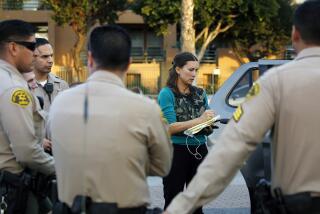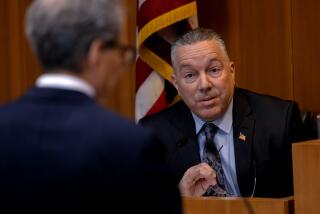Forced to Walk a Fine Line Over Information
- Share via
WASHINGTON -- Striking a respectful and even deferential tone, Montgomery County, Md., Police Chief Charles A. Moose has had a lot to say in recent days to the sniper terrorizing the Washington area. “We do want to talk to you.... We remain open and ready to talk.... If you would feel more comfortable, a private P.O. box number or another secure method can be provided.”
But while broadcasting carefully to an audience of one, authorities have had little to say to millions of anxious residents that might help them assist the police with tips, or even assess their own level of risk in the attacks.
The lack of information has drawn complaints that authorities are withholding key facts from the public. But it stems from a careful balancing act.
“If Moose offends the shooter, then the shooter will go out and do it again,” said Eric Hickey, a professor of criminal psychology at Cal State Fresno. At the same time, some information that may offend the shooter could also help people identify the sniper or determine how to conduct their lives while the shooter is still on the loose.
On Wednesday, debate centered on the decision by authorities to withhold a written threat, apparently from the sniper, that said children in the region were not safe “anywhere, at any time.” The threat was contained in a note found Saturday at the site of the sniper’s 12th shooting, in Virginia, but it was not confirmed until Tuesday afternoon.
The reasons police withheld that detail were unclear. The sniper may have demanded it, or authorities may have feared that releasing it would have unduly panicked the public or revealed information best left secret for investigative reasons.
Still, their reticence had a cost.
“Public confidence is tremendously important, and that was shaken a little bit by law enforcement holding back the information about the threat against children,” said Clinton R. Van Zandt, formerly the FBI’s chief hostage negotiator. “Law enforcement can’t work without the support of the public. If that belief in law enforcement’s ability to solve the case and act in our best regard is eroded, that contributes to anxiety, frustration and fear on the part of the public.”
Similarly, former investigators and criminal behavior experts have asked why police have chosen not to reveal the full text of the Saturday letter or of other written and telephone communications.
“How did we get the Unabomber? By publishing his manifesto, and then his brother called in and said he recognized the writing,” said Robert Fitzpatrick, a private investigator in Boston and former FBI hostage negotiator.
Also puzzling has been Moose’s comment, made at least three times, that the sniper is able to strike people of any race and gender over a wide area, as if acknowledging the attacker’s prowess.
Some specialists saw the comments as a type of protection from liability in case more people are shot, while others saw it as another attempt to build a rapport with the shooter.
Wednesday night Moose again addressed the media as he announced that a federal arrest warrant for a firearms violation had been issued for a man he identified as John Allen Muhammad, who should be considered “armed and dangerous.” But Moose cautioned that the public should not assume that the man was involved in the sniper case.
The chief then issued another cryptic message to the sniper:
“You asked us to say, quote, We have caught the sniper like a duck in a noose, unquote. We understand that hearing us say that is important to you. However, we want you to know how difficult it has been to understand what you want because you have chosen to use only notes, indirect messages and calls to other jurisdictions.... Let’s talk directly. We have an answer for you about your option. We are waiting for you to contact us.”
In these public statements, several specialists said, Moose, the leader of the multi-jurisdiction task force, is surely guided by the FBI’s criminal behavior experts, who try to calculate the effect that each statement or action will have on the killer.
“Even in his manner and tone, he is carefully coached,” said Dr. Michael Welner, a forensic psychiatrist at the New York University School of Medicine. He said Moose was striving to appear “diplomatic” and to build an emotional connection with the sniper.
“When you deal with someone who has the capacity to be destructive, and to do it impulsively, you try to keep him connected, communicating, because it is his alienated quality that enables him to kill,” said Welner, who also leads a consultancy called the Forensics Panel. “The more connected he is, the more difficult it is for him to kill randomly.... What he’s doing is to bridge that gap.... “
Moose’s deferential tone has been so noteworthy that he was asked about it at a news conference Wednesday.
The chief said only that “my parents prefer it if I’m a gentleman at all times.”
Law enforcement officials used a news conference Wednesday to defend their flow of information to the public. “There seem to be a lot of questions about what we’re releasing and when,” acknowledged Michael Bouchard of the federal Bureau of Alcohol, Tobacco and Firearms. But Welner said that to calm public anxiety, police should put out more messages about what kind of person they’re seeking.
“They don’t need to give all the details of the profile, just, ‘If you know a person who is like XYZ or ABC, please tell us,’ ” he said. “You might think that’s unwise because it narrows the investigation, but they’ve got so many clues and they need a narrowing mechanism, and the public needs some guidance. Then the public knows what they can do, and they start mobilizing.”
Van Zandt said another piece in calibrating the public message involved the “hit of emotional heroin” the killer likely receives when his actions are publicized.
“Law enforcement is trying to walk a tightrope between giving the public the information it needs to make its own decisions without creating a public panic,” he said, “and playing totally into the hands of the shooter so that he’s putting out manifestos two or three times a day.... It’s a horrible situation for law enforcement.”
More to Read
Sign up for Essential California
The most important California stories and recommendations in your inbox every morning.
You may occasionally receive promotional content from the Los Angeles Times.













